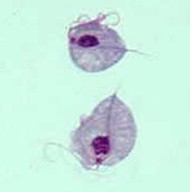 Single-cell trich parasites seen under a microscope. |
TrichomoniasisContents • What Is Trichomoniasis? |
|
Return To Main Articles Sexually Transmitted Diseases The Female Body |
Terminology: Trichomoniasis is also known as trich and trichomonas.
It is a vaginal infection caused by a one-celled parasite Trichomonas vaginalis. Trich is extremely common in young women who are sexually active. As it can be transmitted sexually it is also considered a sexually transmitted disease (STD). To be effective, any treatment needs to be given to both partners. The microorganism can live for years in the male genital tract without causing symptoms. Although trich is the third most common type of vaginitis in the United States, its incidence rate is declining - probably because medications can quickly cure it so it has less chance of spreading.
Trich is nearly always transmitted by sexual contact with an infected partner. During sexual intercourse it is passed from penis to vagina or vagina to penis. It can also be passed from vagina to vagina. It is not common for the organism to infect other parts of the body like the mouth, hands or anus. As the organism can survive outside the body at room temperature for several hours, it may also be transmitted by contact with an infected sheet, washcloth, towel or toilet seat.
Women
Men If your doctor suspects trich he will first perform a pelvic examination looking for the characteristic 'strawberry' cervix - that is small red dots at the entrance to the uterus which result from tiny areas of bleeding. A wet prep (the examination of a sample of the vaginal discharge under microscope) will show if the organism is in vaginal fluids. Sometimes trich is discovered accidentally in asymptomatic women on the basis of an abnormal Pap test result during a routine pelvic exam. Trich is more difficult to diagnose in men and requires a laboratory test. In practice many men don't get a formal diagnosis and are just treated if their partner is infected. Or men may be treated if they have ongoing symptoms of urethral burning or itching despite having been treated for gonorrhea and chlamydia, other STDs. How Is Trichomoniasis Treated? Trich can be cured with a single 2,000 mg dose of prescription oral antibiotics - either metronidazole (Flagyl, Protostat) or tinidazole. 9 out 10 cases will be cured in about a week with this treatment. Metronidazole gels or suppositories are less effective. The male partner should be treated too, regardless of whether or not he has symptoms. People who become nauseated with the large dose of antibiotics can take it in smaller doses 3 times a day over 7 days. You need to avoid drinking alcohol for 24 hours after taking metronidazole. Metronidazole is not considered safe during the first trimester of pregnancy nor in breastfeeding mothers. In rare cases if metronidazole does not work, it can be repeated - if symptoms persist the dose is increased. These stronger treatments seem to be more successful if used in combination with acetic acid douches (like Aci-Jel) and intravaginal metronidazole gels. Homemade douches can be made by mixing 1 tablespoon of vinegar with a quart of water - used once or twice a week. Betadine douches may also help relieve symptoms. If symptoms continue to persist you will need to seek the advice of a specialist consultant. Other Alternative Remedies 1. For a mild case of trich a garlic suppository (peel one clove of garlic and wrap in gauze, insert in the vagina overnight and change daily) can help relieve irritation and itching. Prognosis: Outlook • Long-term untreated infection may cause abnormal cell changes in the cervix. These changes can be detected in a routine Pap smear. In such instances, treatment should be started and the Pap test repeated 3 to 6 months later. How Can Trichomoniasis Be Prevented? 1. Ideally limit sexual activity to mutually monogamous relationships.
|
| Related Articles on STDs
For more useful advice, see the following: • Reproductive disorders: List of common signs. Back to Homepage: Womens Health Advice |
|
WOMENS HEALTH ADVICE: ABOUT SEXUALLY TRANSMITTED DISEASES |